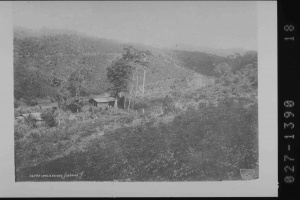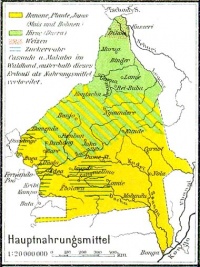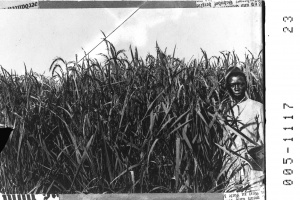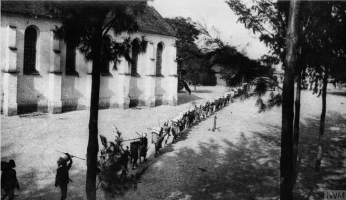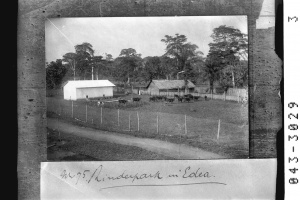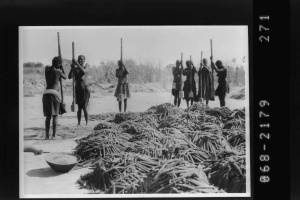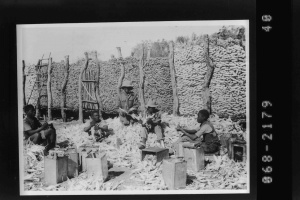Introduction↑
While information is more readily available concerning rations and the health of the forces in Europe, this generally has not been the case for the African theatres, that is until the release of the “Report on Medical and Sanitary Matters in German East Africa 1917” by Army Surgeon General William Pike (1860-1941) and Royal Army Medical Corps Doctor Andrew Balfour (1873-1931).[1] One careful study of famine in central Tanzania between 1917 and 1920 provides the most explicit study on food and famine, while a less-specific consideration of the situation in Nyasaland deals with similar problems there. Beyond these, however, there is little published literature available on food and nutrition in Africa during the First World War, with the result that information must be gleaned from a variety of sources. Several authors have addressed the topic through their discussions of the carriers and military conditions in the East Africa campaign, while others have looked at the military and civil infrastructure, providing some insight into the provision of food during the war years. For the campaigns in West and North Africa, texts commenting on the regional economic situation are also useful for considering the state of nutrition in those areas, as are studies of Africans in the French military.
In contrast to Europe’s Western Front, the campaigns in Africa were mobile. This meant long lines of communication to ensure military equipment and food got to those confronting the enemy. Although each theatre provided its own challenges, all — except perhaps South West Africa — were reliant on people power to transport food and equipment to the front lines. The ability of armies to march was reliant on carriers or porters, who also needed to be fed and maintained. For British forces in East Africa this resulted in multiplying tenfold or more the manpower required to maintain an effective military campaign.[2] In German East Africa, though, the Schutztruppe stockpiled grain, and later livestock, which was then transported in relays, thus ensuring their carriers were never more than a day’s travel from home.[3] The British, Portuguese,[4] and Belgian colonies were, at least initially, reliant on imports to feed their forces, while the French colonies also exported food to sustain the European home front and, when required, supplied their allies, in particular the Belgian Congo.[5] While campaigning, Belgian and Portuguese authorities encouraged their troops to live off the land. Nonetheless, after malaria and dysentery, malnutrition — either directly or by reducing the body’s ability to fight infection — was the largest single cause of death amongst the military and carrier forces in Africa.
The Front Lines↑
Initially, food supplies for the forces in British West, North, and East Africa were mainly from India which had traditionally been responsible for the region’s security, while South Africa looked to supply the forces which served in South West Africa and later in East Africa. Belgian and Portuguese forces in West and East Africa were reliant on the colonial powers for their rations, while France supplemented Belgian rations. All required shipping, which meant delays as priority was given to transporting troops and military material to fight the war. As a result, the various African home fronts were drawn in to fill the gap, with the agricultural production of African colonial subjects especially requisitioned for military needs. German and French forces — at first largely operating within their African colonies — tended to fend for themselves in the field, further increasing the demands on African agriculturalists.
In several of the African campaigns, the supply of water was critically associated with the provision of food. This was most significant in the desert conditions of South West Africa, where not only soldiers but also horses required a daily water ration. In preparation for an invasion, a Union of South Africa Defence Force (UDF) operation — under the pretext of diamond prospecting — dug boreholes in the northern parts of the territory to ensure adequate supplies. For the south, marine transport brought an average of 3.4 million litres of water per ship from Cape Town to Lüderitzbucht to supply all the forces. Sea water was also processed to supplement fresh water supplies. The result of transporting water, and food, meant that out of 133 days of UDF operations in South West Africa, only twenty-four days were spent on direct military operations, the remaining 109 on accumulation of food and other supplies to support the army.[6] In other African theatres, troops needed to preserve the integrity of their available water supply, ensuring it was not contaminated either by the placement of sanitary latrines or locally occurring dangers. In one instance, soldiers defending the important Fayyum Oasis south of Cairo, learned to fear the effects of “Bill Harris” — their name for the bilharzia parasite — whose presence required extraordinary precautions to protect nearby water sources. As a result their “allowance of water was reduced to a minimum,” which in the Egyptian heat was of far more importance than their otherwise adequate ration allotments.[7]
Elsewhere the provision of rations received the greatest emphasis, although the creation of specific dietary standards for the troops and carriers frequently were little more than a bureaucratic exercise. For example, two ration scales were in use for the Cameroon campaign — 2,702 calories for soldiers compared with 1,741 calories for carriers — although neither proved adequate for sustaining the forces.[8] Though ration provisions were supposedly based on scientific nutritional knowledge, for East Africa Pike suggested plans for ration allocation based not only on role — as in Cameroon — but also on perceived dietary preference.[9] Such differences were mostly in terms of meat and its substitutes, though tobacco, rum, and sugar were other variables; all were further distinguished according to whether men were in transit or on the front line.
Dietary directives had little real impact due to the challenges of transport in all the African theatres resulting in complexities and difficulties concerning rations.[10] Despite such seemingly careful planning, “rations often failed to arrive on time or, when they did, proved to be spoiled or the wrong kinds of food,” leading to a variety of problems.[11] Poor communication meant improvements in ration allocations were not transferred from one theatre to another as manpower was shifted to meet demands, especially in East Africa. For example, “maize was supplied to rice-eating Mende carriers [from West Africa] serving on the Rufiji, who refused to eat it.”[12] Similar ration deficiencies also troubled many of the Indians serving in East Africa. Further complications arose when food could not be correctly prepared. For example, carriers in East Africa who often ate partially cooked maize suffered from pellagra.[13] Overall supply deficiencies as well as diverse dietary requirements led to operational problems resulting from undernutrition or sometimes near starvation, as all too often men did not receive sufficient quantities of their staple food to sustain them. Numerous King’s African Rifles askari from Nyasaland remembered often being on greatly reduced rations; “at war we really starved,” one of them later recollected, joining his fellow soldiers in singing about their “hunger, hunger is painful.”[14] A Nigeria Regiment Corporal later admitted that his situation became so desperate on the front line in East Africa that he only “survived by crawling over the corpses and taking rations from the dead bodies.”[15]
Home Fronts↑
The extraordinary impositions of war were felt on African home fronts as well. Though obvious to many, South African writer Owen Letcher (1884-1943) put it succinctly: “Questions of War and Food are interdependent and closely interwoven all the world over.” In his 1918 dispatch from Mozambique, appearing in the Beira News and East Coast Chronicle as he was returning home from three years of wartime service, Letcher reflected on what he had observed in East and Central Africa. “The food question in tropical Africa,” he wrote, “has been accumulating in its influences throughout these last few momentous years … [becoming] a problem of no small difficulty.”[16]
Even Africans who escaped service as soldiers or carriers felt the effects of the war, with local populations in the conflict zones suffering most, continuing through the final weeks of the war in East Africa.[17] Soldiers often raided their properties, commandeering food for their own use and destroying whatever remained to prevent the enemy gaining access to it. With many men serving in the army or as labourers, muscle power to till the earth and prepare the soil for new planting was often no longer available, so less could be planted to replace that taken or destroyed. Moreover, the widespread absence of those who were traditionally the hunters frequently meant village gardens were less protected from ravages of wild animals.[18] In British East Africa the net result was “a ruinous effect on agriculture.”[19] The situation was similar on Nyasaland’s central lakeshore at Nkhota Kota where “women had to take some of the jobs of men. For example, … they used fishing hooks and went down to the lake to fish.”[20] As a girl living nearby, Dorothy Liwewe remembered “women were in real trouble here in the villages” during the war.[21] Whereas many African families and communities had been self-sufficient before the war, they were no longer.
In German East Africa, military authorities seized nearly ten percent of the livestock in Dodoma District. Mzee Mwakala remembered that in his village, “Sagara, the Germans … took a lot of food for their soldiers … not only the millet, but they took the cattle and goats.” The requisitions continued under British occupation, but as the war wore on another Wagogo elder recalled, “Cattle were useless because they were dying in their hundreds due to lack of pastures which resulted from poor rainfall.”[22] For a people whose primary standard of wealth was cattle, these effects brought on by both war and weather were devastating, paralleling the situation about 600 kilometers to the southwest, in northern Nyasaland. There, along the colonial border, both German and British stock seizures led to similar wartime cattle herd depletions. And as a result, the wealthiest among the Ngonde people — who had been cattle-rich before the war — were impoverished. With the armistice, their economic misfortunes in turn affected their social status, not unlike the cattle-poor Wagogo in post-war Dodoma.[23]
For many Africans, the slide into food insufficiency had begun even before the war. A 1912 report on German farm productivity in South West Africa showed that the majority had been living “below the bare minimum standards of nutrition.”[24] The situation had been no better in German East Africa and the Belgian Congo where new administrators were trying to introduce less violent regimes which negatively impacted productivity. Although the Governor of Nigeria reported in 1916 that “food was abundant; … [and] the people were generally well fed and well clad,” he acknowledged that the British colony had “ceased to import foodstuffs from the United Kingdom during the War and living on her own resources supplemented by imports from the United States of America.”[25] In 1917 for the first time the colony imported rice from the United States, an indirect acknowledgement that the local production of foods to maintain Nigeria’s urban population was clearly insufficient. Since territory-wide statistics were then based almost exclusively on reports from the town centres, it is likely more troubling conditions obtained in the rural areas, many of which were yet to see a colonial administrator. The Belgian Congo, too, imported food as rice produced in the Eastern Province was insufficient to feed the Force Publique. Nonetheless, by the end of the war, the health of the Congolese was as low as it had been five years before the war.[26]
Throughout Africa, colonial economies were deeply affected by production shifts required to support the war effort. Many colonial officials requisitioned food to support troops in the field from late 1915 onwards. For example in Nyasaland, the Governor ordered all food production “surplus to the bare needs of the local population” be turned to military use, although many of his subordinates recoiled when Protectorate police were occasionally ordered to seize whatever food they might find in the villages.[27] French West African farmers exported thousands of tons of cereals to Europe for animal feed,[28] but similar requisitioning abuses by police exacerbated the widespread disaffection with African resistance to early French military recruitment.[29] Gradually colonial administrative systems for meeting military food demands became more organised, with rationing introduced in Algeria and elsewhere. Mission stations frequently abandoned their educational work, instead focusing their endeavours on food production, with the Scots missionaries at Livingstonia actually “doing flourishing business” supplying the troops.[30] European planters in Central Africa and elsewhere also came under government orders to turn their efforts away from export commodities to food production, first for the troops and later—as conditions worsened—to counter the effects of threatening famine.
Delayed rains affected the planting of “native food crops” in Nigeria and contributed to a poor cotton yield. These were not helped by an exceptionally wet season that followed. While ground nuts and palm produce were available for export, there was “great difficulty” getting bags for the export trade. The consequence of poor cotton yields and exports in general meant money to purchase food was reduced for Africans in Nigeria,[31] with the picture for the Gold Coast strikingly similar.[32] Although the crops might differ, the issues impacting food production in Nigeria and the Gold Coast were replicated across many other African countries. Floods, late rains, limited shipping and packaging material all played a part, a scenario which — on top of military food requisitions — had by late 1917 brought on one of the worst droughts affecting virtually the whole of Africa. The further away from direct conflict a territory was, the less disruption there was to production, implying better food and nutrition in the territory. But in East and Central Africa, where Owen Letcher observed the situation, famine conditions were severe.
In the Dodoma District of central Tanganyika, first German and then British colonial officials contributed to what historian Gregory Maddox has described as a “man-made famine … caused by the theft of food, cattle, and men from local communities.”[33] By December 1917, the Wagogo people of that region had supplied 35,000 tons of maize for both military and civilian use, while 4,300 head of cattle each month were collected for similar purposes. “The only change in the situation after the British occupied the region,” Maddox wryly observes, “was the language in which the demands were made.”[34] Hunger became so great that leather sandals were repurposed and boiled for food. Similar deprivations produced comparable problems further north in Egypt, where the local population was disrupted by the Gallipoli invasion and its aftermath. As a result, malnutrition and a general decrease in public health through typhoid epidemics, fever, and plague ensued as the war continued,[35] with a noticeable increase in deaths due to malnutrition between 1916 and 1918.[36] In Nyasaland “government relief measures … could not prevent deaths taking place among the most vulnerable sections of the population” even as the war was ending.[37]
In Ugogo, Mzee Gazo, recalled that “very many died” during what his people called the Mtunya, or “scramble,” adding:
Similar food shortages and even sometimes outright famine conditions became severe enough elsewhere on the continent that during and after the war Africans often flooded to the towns in search of wage labour and food. In Nigeria, some combat veterans also reported they were attracted to urban areas to satisfy their “appetites for a new range of foodstuffs and consumer goods” which they had come to enjoy during their wartime service.[39] However motivated, these food quests ironically resulted in greater food shortages in many places, a situation made worse as prices increased. In Sierra Leone, as was true elsewhere, this led to government intervention and experiments in diversifying food products.[40]
Deaths and the debilitation of the remaining population not only impacted the production of food, but in turn affected the resilience of the inhabitants and their resistance to disease. Even localized epidemics caused further food shortages. An apt example occurred in the Marungu Massif, east of Lake Tanganyika, where an outbreak of cerebrospinal meningitis occurred just as famine conditions hit a peak early in 1918. That crisis was shortly followed by a whooping cough epidemic and many cases of pneumonia. But there, as elsewhere in Africa, the most devastating impact of nutritional deficiencies which accompanied the war became apparent when the worldwide influenza pandemic hit Africa and moved along the supply lines.[41] Nearly everywhere, Africans were physically too weak to offer effective resistance against the new virus. Colonial medical professionals were almost uniformly unable to offer much relief to the African populations under their care; in fact, by one assessment “the true magnitude of the disaster was never fully appreciated” by those in charge.[42] Yet in their weakened state, it seems all but certain that at least 2 million and perhaps more Africans died as a result of the 1918-1919 influenza pandemic,[43] “perhaps 8-10 times more than died campaigning during the war itself.”[44]
Conclusion↑
While little literature is directly available on the topic of food and nutrition in Africa during the First World War, the available evidence suggests that the war affected the quantity and quality of food available in most of Africa. Military recruitment — and especially demands for carrier service — affected many areas by depleting the labour supply at a time when increased food production was required to support troops in the field. However, those regions which experienced conflict directly suffered most from food insecurity. In addition to a shortage of manpower to work the land, the meagre supplies found in many African villages were frequently raided by passing military forces. When famine became most severe just as the war was ending, disease — especially the worldwide influenza pandemic — took a further toll on African peoples whose nutritional well-being had been greatly compromised.
Anne Samson, Great War in Africa Association
Melvin E. Page, East Tennessee State University
Reviewed by external referees on behalf of the General Editors
Notes
- ↑ Pike, William / Balfour, Andrew: Report on Medical and Sanitary Matters in German East Africa 1917, 3 December 1917, The National Archives (UK): WO 141/31 (hereafter referred to as Pike Report).
- ↑ See Paice, Edward: Tip and Run: The Untold Tragedy of the Great War in Africa, London 2007, p. 286.
- ↑ Maddox, Gregory: Mtunya: Famine in Central Tanzania 1917-1920, in: Journal of African History 31/2 (1990), p. 183.
- ↑ Fernanda Rolo, Maria / Pires, Ana Paula: Food and Nutrition (Portugal), in: 1914-1918-online. International Encyclopedia of the First World War, ed. by Janz, Oliver et al., issued by Freie Universität Berlin, Berlin 2016-12-08. DOI: 10.15463/ie1418.11018 (retrieved 15 January 2019).
- ↑ Schulten, Oliver: When two elephants clash it’s the grass that suffers: East Africa during the First World War, in: Samson, Anne et al. (eds.): There came a time: Essays on the Great War in Africa, Rickmansworth 2016, p. 178.
- ↑ Kleynhans, Evert: A critical analysis of the impact of water on the South African campaign in German South West Africa, 1914-1915, in: Historia 61/1 (2016), pp. 29-53.
- ↑ Briggs, Martin S.: Through Egypt in War Time. London 1918, p. 50.
- ↑ Killingray, David / Matthews, James: Beasts of Burden: British West African carriers in the First World War, in: Canadian Journal of African Studies 13/1 (1979), p. 17.
- ↑ Pike Report, pp. 55-64.
- ↑ Gorges, Howard: The Great War in West Africa, Uckfield 2004, pp. 156, 248-253.
- ↑ Killingray / Matthews, Beasts of Burden, p. 17.
- ↑ Ibid.
- ↑ Pike Report, pp. 55-56.
- ↑ Quoted in Page, Melvin E.: The Chiwaya War, Boulder 2000, pp. 96-97.
- ↑ Quoted in Matthews, James K.: Clock Towers for the Colonized: Demobilization of the Nigerian Military and the Readjustment of Its Veterans to Civilian Life, 1918-1925, in: International Journal of African Historical Studies 14/2 (1981), p. 269.
- ↑ Quoted in Page, Melvin E.: Introduction: Black Men in a White Men’s War, in: Page, Melvin E. (ed.): Africa and the First World War, London 1987.
- ↑ See Moyd, Michelle R.: Violent Intermediaries: African Soldiers, Conquest, and Everyday Colonialism in German East Africa, Athens 2014, p. 144.
- ↑ Yorke, Edmund James: Britain, Northern Rhodesia and the First World War. London 2016, p. 58.
- ↑ Hodges, Geoffrey: Military Labour in East Africa and its Impact on Kenya, in: Page (ed.), Africa and the First World War 1987, p. 142.
- ↑ Mr. Kaunda, interviewed on 15 April 1973 by Solomon Liwewe in Maluma Village, Nkhota Kota District, Malawi. Details regarding this as well as other interviews are in Page, Chiwaya War 2000, pp. 236-238.
- ↑ Quoted in Page, Chiwaya War 2000, p. 134.
- ↑ Both quoted in Maddox, Mtunya 1990, pp. 183, 187.
- ↑ Page, Chiwaya War 2000, p. 205.
- ↑ Gad, Johannes: Die Betriebsverhältnisse der Farmen des mittleren Hererolandes (Deutsch Südwest-Afrika). Hamburg 1915, in: Eriksen, Tore Linné / Moorsom Richard: The Political Economy of Namibia: An Annotated Critical Bibliography, Uppsala 1985, p. 118.
- ↑ Colonial Report for Nigeria, 1916, p. 7, online: https://libsysdigi.library.illinois.edu/ilharvest/Africana/ Books2011-05/3064634/3064634_1916/3064634_1916_opt.pdf (retrieved 10 May 2020).
- ↑ Province de Liege, La Grande Guerre vue de la Province de Liège et de Belgique, 2014-2018, pp. 51-2, online https://www.provincedeliege.be/sites/default/files/media/524/EPL%20-%20Dossier%2014-18.pdf (retrieved 27 May 2020).
- ↑ Page, Chiwaya War 2000, p. 132.
- ↑ Michel, Marc: L’Appel à L’Afrique: Contributions et reactions à l’effort de guerre en A.O.F. (1914-1918), Paris 1982, p. 155; Tourte, René: Histoire de la recherche Agricole en Afrique Tropicale Francophone, vol 4, United Nations 2005, pp.14ff, 135.
- ↑ Echenberg, Myron: Colonial Conscripts: The Tirailleurs Sénégalais in French West Africa, 1857-1960, Portsmouth 1991, p. 41.
- ↑ McCracken, John: Politics and Christianity in Malawi 1875-1940, Cambridge 1977, p. 223.
- ↑ Colonial Report for Nigeria, 1918, p. 7.
- ↑ Gold Coast Report, 1918, p. 32, online: https://libsysdigi.library.illinois.edu/ilharvest/Africana/Books2011-05/3064634/3064634_1918/3064634_1918_opt.pdf (retrieved 10 May 2020).
- ↑ Maddox, Mtunya 1990, p. 197.
- ↑ Ibid., p. 184.
- ↑ Gallagher, Nancy Elizabeth: Egypt’s other wars: Epidemics and the politics of public health, Syracuse 1990, p. 12.
- ↑ Beinin, Joel / Lockman, Zachary: Workers on the Nile. Nationalism, communism, Islam, and the Egyptian working class, 1882-1954, Princeton 1987, p. 85.
- ↑ McCracken, John: A History of Malawi, 1859-1966, Woodbridge 2012, p. 154.
- ↑ Quoted in Maddox, Mtunya 1990, p. 186.
- ↑ Matthews, James K.: World War I and the Rise of African Nationalism: Nigerian Veterans as Catalysts of Change, in: Journal of Modern African Studies 20/3 (1982), p. 494.
- ↑ Cole, Festus: Sierra Leone and World War 1, PhD thesis, SOAS, University of London 1994, chapter 9, esp. p. 340.
- ↑ Roberts, Allen F.: ‘Insidious Conquests’: Wartime Politics Along the South-western Shore of Lake Tanganyika, in: Page (ed.): Africa and the First World War 1987, p. 198.
- ↑ Balfour, A. / Scott, H. H.: Health Problems of the Empire: Past, Present, and Future, London 1924, p. 219.
- ↑ Patterson, K. David: The demographic impact of the 1918-19 influenza pandemic in sub-Saharan Africa: A tentative assessment, in: Fyfe, Christopher / McMaster, David (eds.): African Historical Demography, v. II, Edinburgh 1981, pp. 401-431; Phillips, Howard: Influenza Pandemic (Africa), in: 1914-1918-online. International Encyclopedia of the First World War, ed. by Janz, Oliver et al., issued by Freie Universität Berlin, Berlin 2014-10-08. DOI: 10.15463/ie1418.10431 (retreived 30 December 2019).
- ↑ Page, Black Men in a White Men’s War 1987, p. 16.
Selected Bibliography
- Anderson, Ross: The forgotten front. The East African campaign, 1914-1918, Stroud 2004: Tempus.
- Echenberg, Myron J.: Colonial conscripts. The Tirailleurs Sénégalais in French West Africa, 1857-1960, Portsmouth; London 1991: Heinemann; J. Currey.
- Gallagher, Nancy Elizabeth: Egypt's other wars. Epidemics and the politics of public health, Syracuse 1990: Syracuse University Press.
- Gewald, Jan-Bart: Forged in the Great War. People, transport, and labour, the establishment of colonial rule in Zambia, 1890-1920, Leiden 2015: African Studies Centre.
- Gorges, Edmund Howard: The Great War in West Africa, London 1930: Hutchinson & Co.
- Hodges, Geoffrey: Kariakor. The carrier corps. The story of the military labour forces in the conquest of German East Africa, 1914 to 1918, Nairobi 1999: Nairobi University Press.
- Killingray, David; Matthews, James K.: Beasts of burden. British West African carriers in the First World War, in: Canadian Journal of African Studies 13/1/2, 1979, pp. 5-23.
- Kleynhans, Evert: A critical analysis of the impact of water on the South African campaign in German South West Africa, 1914-1915, in: Historia 61/2, 2016, pp. 29-53.
- Lettow-Vorbeck, Paul von: My reminiscences of East Africa, London 1920: Hurst and Blackett.
- Maddox, Gregory: Mtunya. Famine in Central Tanzania, 1917-20, in: The Journal of African History 31/2, 1990, pp. 181-197, doi:10.1017/S0021853700024993.
- Michel, Marc: L'appel à l'Afrique. Contributions et réactions à l'effort de guerre en A.O.F. (1914-1919), Paris 1982: Publications de la Sorbonne.
- Page, Melvin E.: The Chiwaya war. Malawians and the First World War, Boulder 2000: Westview Press.
- Page, Melvin E. (ed.): Africa and the First World War, New York 1987: St. Martin's Press.
- Paice, Edward: Tip and run. The untold tragedy of the Great War in Africa, London 2007: Weidenfeld & Nicolson.
- Samson, Anne / Pires, Ana Paula / Gilfoyle, Daniel (eds.): There came a time .... Essays on the Great War in Africa, Rickmansworth 2018: GWAA/TSL Publications.
- The National Archives, Kew, WO 141/31. Report on Medical and Sanitary Matters in German East Africa 1917
- Tourte, René: Histoire de la recherche Agricole en Afrique Tropicale Francophone. La période colonial et les grands moments des jardins d’essais, 1885/1890-1914/1918, volume 4, Rome 2005: FAO.
- Yorke, Edmund James: Britain, Northern Rhodesia and the First World War. Forgotten colonial crisis, London 2016: Palgrave Macmillan.






